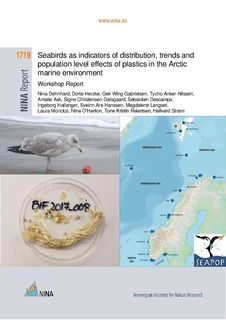| dc.description.abstract | Nina Dehnhard, Dorte Herzke, Geir Wing Gabrielsen, Tycho Anker-Nilssen, Amalie Ask, Signe Christensen-Dalsgaard, Sebastien Descamps, Ingeborg Hallanger, Sveinn Are Hanssen, Magdalene Langset, Laura Monclús, Nina O’Hanlon, Tone Kristin Reiertsen & Hallvard Strøm 2019. Seabirds as indicators of distribution, trends and population level effects of plastic in the Arctic marine environment – Workshop Report. NINA Report 1719. Norwegian Institute for Nature Research.
Plastic pollution is a global and increasing threat to ecosystems. Plastics in the oceans are une-venly distributed, are transported by currents and can now be found in the most remote environ-ments, including Arctic sea ice. The entanglement of wildlife by large plastic debris such as ropes is an obvious and well documented threat. However, the risks associated with the ingestion of smaller plastic particles, including microplastics (< 5mm) have been largely overlooked. Recent studies show that microplastic accumulates in the food web. Even in the Arctic and the deep sea, fish frequently contain microplastics in their guts. This, together with the fact that small micro-plastic particles can pass from the gut into blood and organs and also leach associated toxic additives raises health concerns for wildlife that ingest microplastic.
Within the North Atlantic, plastic ingestion in seabirds has been studied systematically only in the northern fulmar (Fulmarus glacialis), for which plastic particles > 1mm found in the stomachs of dead (beached or bycaught) birds are quantified. With the origin of these birds being unknown, it is, however, impossible to assess how plastics affect populations even of this one monitored species, let alone for other seabird species that differ in their foraging behaviour and risk to ingest plastics.
This report sums up the results of a workshop which aimed to identify possibilities for long-term monitoring of (micro-) plastic ingestion by seabirds in the framework of SEAPOP, the basal pro-gramme monitoring the performance of Norwegian seabird populations (www.seapop.no). The key conclusions were: 1) There is a need for baseline information on plastic ingestion across all seabird species to identify which species and populations are most suitable for monitoring. To obtain this information, the best approach is to investigate the stomach contents of dead birds (i.e. comparable methodology across all species). For long-term monitoring, not only species with high plastic ingestion are of interest, but also those with low plastic prevalence. 2) In the absence of information from (1), eight species that are complementary in their foraging behaviour and have a wide distribution range were selected as preliminary species of interest to monitor plastic ingestion. 3) For minimally invasive monitoring, regurgitates, fresh prey items and faeces are most suitable; 4) More information on prevalence of plastic ingestion is needed to identify optimal sample sizes for long-term monitoring. We therefore highlight the need for several pilot studies before establishing a plastic monitoring protocol within SEAPOP. | nb_NO |
